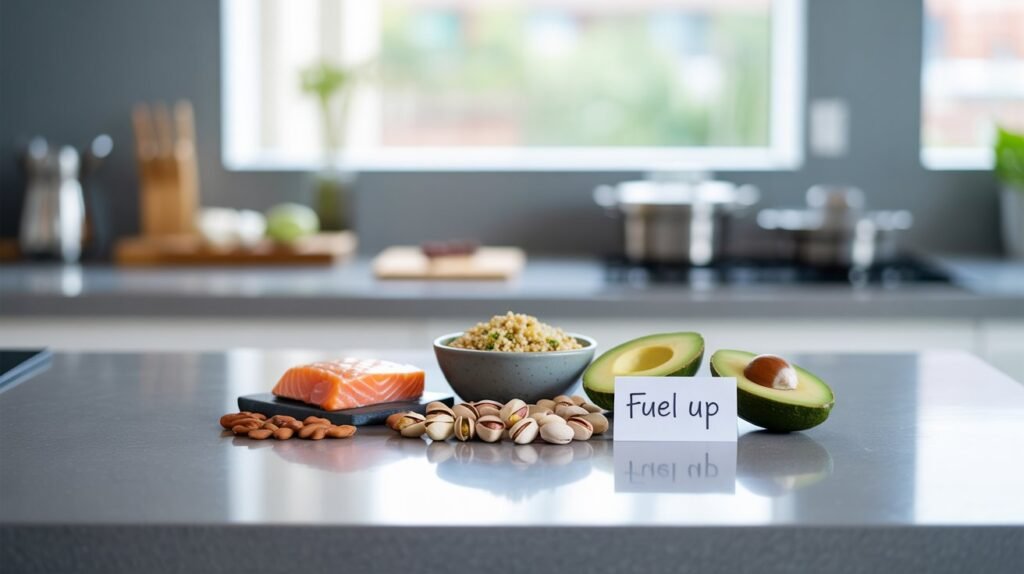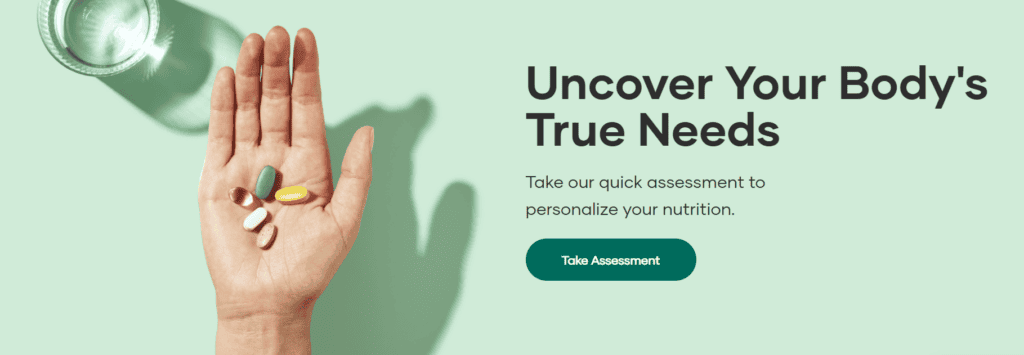
If you’ve ever dived into the world of health and nutrition, you’ve probably heard the word “macronutrients” thrown around.
It might sound like something out of a science textbook, but trust me—tracking your macros doesn’t have to be complicated or intimidating.
It’s actually a game-changer when it comes to understanding your diet and making smarter food choices. Let’s break it all down in plain English (and with a friendly tone, of course).
Affiliate Disclaimer: This page contains affiliate links for products we have used for 43 years and receive compensation, at no extra cost to you, if you make a purchase using the links provided. We appreciate your support so much and we’re here to help in any way we can.
What Are Macronutrients, Anyway?
To put it simply, macronutrients (or macros) are the nutrients your body needs in large amounts to function properly. There are three main types:
- Carbohydrates – Your body’s main source of energy. Think of carbs as the fuel that keeps your engine running. Foods like bread, rice, pasta, fruits, and veggies are rich in carbs.
- Proteins – The building blocks of your body. Protein is crucial for repairing tissues and building muscle. You’ll find it in foods like chicken, fish, beans, tofu, and eggs.
- Fats – Don’t fear fats! They’re essential for hormone production, brain health, and energy storage. Healthy fats can be found in avocados, nuts, seeds, olive oil, and fatty fish like salmon.
Each of these macronutrients plays a unique and vital role in keeping you alive and thriving. The key is finding the right balance for your individual goals.
Why Track Your Macros?
Here’s the deal: tracking your macros isn’t about being obsessive or restrictive. It’s about understanding what you’re eating and why. By keeping an eye on your macro intake, you can:
- Tailor your diet to your goals: Whether you’re looking to lose weight, gain muscle, or simply maintain a healthy lifestyle, adjusting your macros can help you get there.
- Make better food choices: When you know your macros, you start to see food as fuel. You might rethink that fast-food burger when you realize how it throws off your balance of carbs, fats, and proteins.
- Avoid extremes: Tracking macros can help prevent you from going too low on fats (which can mess with hormones) or overloading on carbs.
Practical Tips for Tracking Macros
So, how do you actually go about tracking your macros? Here are some simple steps to get started:
- Calculate Your Macro Needs: This is where tools like your macronutrient calculator come in handy. Based on factors like your age, weight, activity level, and goals, it’ll give you a personalized breakdown of how many grams of carbs, protein, and fat you should aim for each day.
- Use a Food Tracking App: One of these apps can make it easy to log your meals and keep track of your macro intake. They often come with a database of foods, so you don’t have to manually calculate everything.
- Plan Your Meals: Once you know your macro goals, plan your meals around them. For example, if you’re low on protein for the day, you might add a grilled chicken breast to your dinner. If you need more healthy fats, toss some avocado into your salad.

Real-Life Examples: Finding Balance
Let’s take a look at a day of eating for someone tracking their macros.
- Breakfast: Scrambled eggs (protein and fats) with whole-grain toast (carbs) and a side of fruit (carbs).
- Lunch: Grilled chicken salad with olive oil-based dressing (protein, fats, and carbs from veggies).
- Snack: A handful of almonds (healthy fats) and Greek yogurt (protein).
- Dinner: Baked salmon (protein and fats) with quinoa and steamed broccoli (carbs and fiber).
- Dessert: A square of dark chocolate (because life’s too short!).
Notice how each meal is balanced with a mix of macronutrients? That’s the goal!
My Experience with Tracking Macros
When I started tracking my macros, I was blown away by how much I learned about my eating habits. For example, I realized I wasn’t eating nearly enough protein to support my fitness goals. By tweaking my meals (hello, chicken and protein shakes!), I started seeing results faster.
My Pro Tip: Tracking macros helped me enjoy treats more guilt-free. I could fit a slice of pizza or a scoop of ice cream into my day as long as it didn’t throw off my overall balance. It’s all about moderation, not deprivation.
Carbohydrates: Your Body’s Fuel Source
Carbs often get a bad rap, but they’re actually your body’s primary source of energy. When you eat carbs, your body breaks them down into glucose (sugar), which fuels everything from your brain to your muscles. Skimping on carbs can leave you feeling tired, cranky, and struggling to focus.
There are two main types of carbs: simple carbs and complex carbs.
- Simple carbs are quickly digested and provide immediate energy. Think of foods like sugar, candy, and white bread. While they’re okay in moderation, too many can cause blood sugar spikes and crashes.
- Complex carbs, on the other hand, take longer to digest and provide sustained energy. Foods like whole grains, beans, and vegetables fall into this category. They’re also packed with fiber, which helps keep you full and supports healthy digestion.
Here’s an example: Let’s say you have a big workout planned. A bowl of oatmeal (a complex carb) with a banana (a mix of simple and complex carbs) is a great pre-workout meal. The oatmeal provides slow-burning energy, while the banana gives you a quick boost to get started.
Pro Tip: Not all carbs are created equal. Focus on whole, minimally processed sources of carbs rather than sugary snacks or refined grains. Your body (and mood) will thank you!

Protein: The Builder and Repairman
If carbs are the fuel, protein is the construction crew. Protein is essential for building and repairing tissues, making enzymes and hormones, and supporting your immune system. It’s especially important for anyone trying to build muscle, recover from injuries, or stay active.
Protein is made up of amino acids, which are like tiny building blocks. Some of these amino acids are “essential,” meaning your body can’t produce them on its own—you have to get them through food.
Common protein sources include:
- Animal-based: Chicken, beef, fish, eggs, and dairy products.
- Plant-based: Beans, lentils, tofu, tempeh, and quinoa.
For example, if you’re a vegetarian, a hearty lentil curry with rice is a great way to hit your protein goals. Lentils provide protein and fiber, while rice adds a complementary amino acid profile to make it a “complete” protein source.
Pro Tip: Spread your protein intake throughout the day. Instead of loading up on one protein-heavy meal, aim to include a source of protein with every meal and snack. This helps with muscle repair and keeps hunger at bay.
Fats: The Unsung Hero
For years, fat was unfairly vilified, but times have changed. Fats are not only an essential macronutrient—they’re downright crucial for your health. They play a role in brain function, hormone production, and absorbing fat-soluble vitamins (like vitamins A, D, E, and K). Plus, fats help keep you full and satisfied.
Like carbs, not all fats are created equal. Here are the main types:
- Healthy fats: These include unsaturated fats (monounsaturated and polyunsaturated) found in foods like avocados, olive oil, nuts, seeds, and fatty fish.
- Unhealthy fats: These include trans fats (found in some processed foods) and excessive amounts of saturated fats. While saturated fats (like butter or cheese) aren’t as bad as once believed, they’re best enjoyed in moderation.
Imagine it’s snack time, and you’re reaching for something to tide you over until dinner. Instead of chips, go for a handful of almonds or a slice of whole-grain toast with avocado. Both provide healthy fats that keep your energy steady and your hunger in check.
Pro Tip: Incorporate a variety of healthy fats into your diet. For example, drizzle olive oil on your salad, sprinkle flaxseeds on your oatmeal, or enjoy a piece of salmon for dinner.
Breakfast Options:
- Greek Yogurt Parfait: Greek yogurt (protein), topped with granola (carbs) and a handful of walnuts (healthy fats).
- Avocado Toast with Eggs: Whole-grain toast (carbs) spread with avocado (healthy fats) and a fried or poached egg (protein).
- Smoothie: A blend of spinach, frozen berries (carbs), almond butter (fats), and a scoop of protein powder (protein).
Lunch Ideas:
- Turkey and Avocado Wrap: Whole-grain tortilla (carbs) filled with turkey slices (protein), avocado slices (fats), and a mix of veggies like lettuce and tomatoes (carbs and fiber).
- Grilled Chicken Salad: Grilled chicken breast (protein) on a bed of leafy greens and colorful veggies (carbs) with olive oil and lemon dressing (fats).
- Quinoa Bowl: Quinoa (carbs) topped with black beans (protein), sautéed veggies (carbs), and a dollop of guacamole (fats).
Snack Suggestions:
- Apple with Peanut Butter: Apple slices (carbs) paired with a tablespoon of peanut butter (healthy fats and protein).
- Cheese and Crackers: Whole-grain crackers (carbs) with slices of cheddar cheese (protein and fats).
- Trail Mix: A mix of almonds, cashews (fats), dried cranberries (carbs), and sunflower seeds (protein and fats).
Dinner Examples:
- Salmon with Sweet Potato and Asparagus: Baked salmon (protein and fats), a roasted sweet potato (carbs), and steamed asparagus (carbs and fiber).
- Stir-Fry: Chicken or shrimp (protein) stir-fried with broccoli, bell peppers, and carrots (carbs), cooked in sesame oil (fats) and served over brown rice or quinoa (carbs).
- Stuffed Bell Peppers: Bell peppers (carbs) stuffed with a mixture of ground turkey (protein), cooked quinoa (carbs), and shredded cheese (protein and fats).
Desserts That Fit Your Macros:
- Dark Chocolate Almond Bark: Dark chocolate squares (fats) with crushed almonds (fats and protein).
- Chia Seed Pudding: Chia seeds soaked in almond milk (healthy fats) with a drizzle of honey and fresh berries (carbs).
- Protein Mug Cake: A quick microwave mug cake made with protein powder (protein), almond flour (fats), and a splash of almond milk.
The Role of Macronutrients in Overall Health
Each of the three macronutrients—carbohydrates, protein, and fats—has a unique role in keeping your body functioning optimally. Think of them as the essential pillars that support your health, energy levels, and daily activities. Here’s how they each contribute:
Carbohydrates: The Energy Powerhouse
Carbs are your body’s primary energy source. When you eat carbs, your body converts them into glucose, which fuels your brain, muscles, and other tissues. Without enough carbs, you might feel sluggish, irritable, or find it difficult to concentrate. Carbs are especially crucial for:
- Brain Function: Your brain relies on glucose almost exclusively for energy, making carbs essential for mental focus, memory, and cognitive function.
- Physical Activity: Carbs provide the quick energy you need for workouts, running errands, or chasing after kids. For athletes, they are critical for performance and recovery.
Healthy carbs, like whole grains, fruits, and vegetables, also provide fiber, which aids in digestion, supports gut health, and helps prevent diseases like diabetes and heart disease.
Proteins: The Body’s Building Blocks
Protein is essential for growth, repair, and maintenance. Every cell in your body—whether it’s skin, muscle, or organ tissue—requires protein to function properly. Here’s how it supports your overall health:
- Muscle Repair and Growth: Protein helps repair damaged tissues and build lean muscle, making it a must for anyone who exercises regularly.
- Hormones and Enzymes: Many hormones (like insulin) and enzymes are made from protein, and these are crucial for processes like digestion and metabolism.
- Immune Support: Protein helps build antibodies that fight infections and keep your immune system strong.
Your body doesn’t store protein the way it does fats or carbs, so it’s important to include it in your diet daily to keep all systems running smoothly.
Fats: The Multi-Tasker
Fats often get a bad reputation, but they’re absolutely essential for overall health. Here’s why fats are so important:
- Energy Storage: Fats provide a concentrated source of energy, especially for long-duration, low-intensity activities.
- Hormone Production: Fats are crucial for producing hormones that regulate metabolism, reproduction, and stress.
- Brain and Nerve Health: Your brain is nearly 60% fat, and healthy fats (like omega-3s) are vital for cognitive function, memory, and mood regulation.
- Nutrient Absorption: Fats help your body absorb fat-soluble vitamins like A, D, E, and K, which are essential for immune function, bone health, and more.
Choosing healthy fats like avocados, olive oil, nuts, seeds, and fatty fish ensures you get these benefits while supporting heart health and reducing inflammation.
The Bigger Picture
Balancing your intake of carbs, proteins, and fats ensures your body gets the energy and nutrients it needs to thrive. Each macronutrient plays a distinct role, but they’re all interconnected. For example, carbs fuel your workouts, protein repairs your muscles, and fats support hormone production—all working together to keep you healthy, energetic, and ready to tackle life’s challenges.
Final Thoughts
Tracking your macros might sound like an extra step, but it’s one of the most powerful tools for understanding and improving your diet. Once you get the hang of it, it becomes second nature—and the results are well worth the effort. Whether you’re looking to hit specific health goals or simply feel more in control of your eating, give it a try. You might just find it’s the missing piece of your nutrition puzzle.
To learn more about the nutrition that will help your unique body stay healthy, take the free personalized health assessment that the brand we partner with offers with no obligation to purchase anything.

The natural nutrition brand we recommend here on the blog are products we have personally used for the past 43+ years. We are not medical professionals. We are on a personal health journey to live younger, energized and healthy longer.
*These statements have not been evaluated by the Food and Drug Administration. These products are not intended to diagnose, treat, cure, or prevent any disease.
